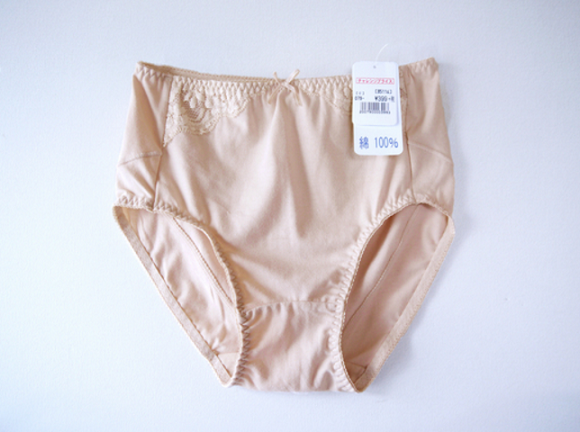
Artist behind the product says he’s making a point about modern society.
As I’m sure my high school English teachers take great pride in, I regularly write about panties in a professional capacity. With that experience, I’ve come to develop a pretty solid concept of how lingerie is priced in Japan.
Ordinary, off-the-rack bra and panty sets will usually set you back somewhere around 3,000 yen (US$27) or so. For novelty lingerie or more intricate designs, however, you can expect to pay north of 5,000 yen, and in cases for such price-inelastic items as certain anime-themed articles of intimate apparel, you might need to shell out as much as 20,000 yen.
However, there’s no pricing precedent for the above-pictured pair of panties being offered here through Japanese website Tagboat. Yes, they are all-silk, but even that upscale material doesn’t seem to warrant the listed price of 90,001,600 yen (US$812,000). Add in the 7,200,128 yen worth of sales tax, and the grand total comes to 97,201,728 yen (US$877,000) (shipping, thankfully, is free).
So why are they so expensive? Well, Tagboat isn’t a clothing retailer. It’s a modern art marketplace, and the panties, officially called “The Only Panties Like This in the World,” are the brainchild of artist Samurai Masa. You may remember Masa from that time when he was selling a glass teapot with a pair of granny panties stuffed in them for a mere one million yen. The artist claims to be a descendent of the Toyotomi samurai clan, and his Tagboat profile includes:
”With [Masa’s] experiences in art and self-studies in contemporary art, he started to pursue his passion in the art world with underwear as his weapon…Coming from a long line of artistic talents, his ancestors also had a relationship with many cultural celebrities, heroes, and heroines in history. A samurai, surviving in the current world, is going into the world of art not with a sword, but with underwear.”
The only noteworthy feature of the underwear is their thick, anti-incontinence material. Masa didn’t make them himself, instead picking them up at a local supermarket (if you squint, you can see the original, still-attached price tag of just 390 yen). Masa describes the impetus behind his repricing and resale as:
“I feel that the recent advance of excessive materialism, brought on by profit-orientation and free competition, has disrupted the balance and values of the world. Through this artwork, I intend to once again bring to light the problems of the societal system called capitalism.”
Slapping a high price on something that provides no extra benefits compared to less expensive substitutes that provide the same benefits speaks to an extremely shaky understanding of how capitalism works, since that’s exactly the sort of business venture that capitalism tends to mercilessly eliminate. As an art piece, though, it’s certainly got people talking, even if none of them are buying.
Source: Tagboat via Nari Nari
Top image: Tagboat
Follow Casey on Twitter for more things his English teachers may or may not be proud to know he writes about.

 PanTea? This pair of granny panties in a teapot can be yours for only 1 million yen!
PanTea? This pair of granny panties in a teapot can be yours for only 1 million yen! Board of education suspends Japanese teacher who stockpiled 750 pairs of panties at school
Board of education suspends Japanese teacher who stockpiled 750 pairs of panties at school New line of anime panties slip off the animated characters on onto cold drink bottles 【Photos】
New line of anime panties slip off the animated characters on onto cold drink bottles 【Photos】 Bras and panties for men – Online retailer in Japan offers men the chance to feel pretty
Bras and panties for men – Online retailer in Japan offers men the chance to feel pretty Evangelion undies are back, but this time for male fans of the hit science fiction anime
Evangelion undies are back, but this time for male fans of the hit science fiction anime McDonald’s new Happy Meals offer up cute and practical Sanrio lifestyle goods
McDonald’s new Happy Meals offer up cute and practical Sanrio lifestyle goods All-you-can-drink Starbucks and amazing views part of Tokyo’s new 170 meter-high sky lounge
All-you-can-drink Starbucks and amazing views part of Tokyo’s new 170 meter-high sky lounge More foreign tourists than ever before in history visited Japan last month
More foreign tourists than ever before in history visited Japan last month Starbucks reopens at Shibuya Scramble Crossing with new look and design concept
Starbucks reopens at Shibuya Scramble Crossing with new look and design concept Beautiful Sailor Moon manhole cover coasters being given out for free by Tokyo tourist center
Beautiful Sailor Moon manhole cover coasters being given out for free by Tokyo tourist center Mister Donut ready to make hojicha dreams come true in latest collab with Kyoto tea merchant
Mister Donut ready to make hojicha dreams come true in latest collab with Kyoto tea merchant Is the new Shinkansen Train Desk ticket worth it?
Is the new Shinkansen Train Desk ticket worth it? The oldest tunnel in Japan is believed to be haunted, and strange things happen when we go there
The oldest tunnel in Japan is believed to be haunted, and strange things happen when we go there 10 awesome ice creams available from convenience stores in Japan
10 awesome ice creams available from convenience stores in Japan Arrest proves a common Japanese saying about apologies and police
Arrest proves a common Japanese saying about apologies and police Disney princesses get official manga makeovers for Manga Princess Cafe opening in Tokyo
Disney princesses get official manga makeovers for Manga Princess Cafe opening in Tokyo We try out “Chan Ramen”, an underground type of ramen popular in the ramen community
We try out “Chan Ramen”, an underground type of ramen popular in the ramen community Beautiful new Final Fantasy T-shirt collection on the way from Uniqlo【Photos】
Beautiful new Final Fantasy T-shirt collection on the way from Uniqlo【Photos】 Foreign English teachers in Japan pick their favorite Japanese-language phrases【Survey】
Foreign English teachers in Japan pick their favorite Japanese-language phrases【Survey】 There’s a park inside Japan where you can also see Japan inside the park
There’s a park inside Japan where you can also see Japan inside the park Japanese convenience store packs a whole bento into an onigiri rice ball
Japanese convenience store packs a whole bento into an onigiri rice ball Studio Ghibli releases Kiki’s Delivery Service chocolate cake pouches in Japan
Studio Ghibli releases Kiki’s Delivery Service chocolate cake pouches in Japan Japan’s bone-breaking and record-breaking roller coaster is permanently shutting down
Japan’s bone-breaking and record-breaking roller coaster is permanently shutting down New definition of “Japanese whiskey” goes into effect to prevent fakes from fooling overseas buyers
New definition of “Japanese whiskey” goes into effect to prevent fakes from fooling overseas buyers Foreign passenger shoves conductor on one of the last full runs for Japan’s Thunderbird train
Foreign passenger shoves conductor on one of the last full runs for Japan’s Thunderbird train Our Japanese reporter visits Costco in the U.S., finds super American and very Japanese things
Our Japanese reporter visits Costco in the U.S., finds super American and very Japanese things Kyoto bans tourists from geisha alleys in Gion, with fines for those who don’t follow rules
Kyoto bans tourists from geisha alleys in Gion, with fines for those who don’t follow rules Studio Ghibli unveils Mother’s Day gift set that captures the love in My Neighbour Totoro
Studio Ghibli unveils Mother’s Day gift set that captures the love in My Neighbour Totoro Domino’s Japan now sells…pizza ears?
Domino’s Japan now sells…pizza ears? New Japanese KitKat flavour stars Sanrio characters, including Hello Kitty
New Japanese KitKat flavour stars Sanrio characters, including Hello Kitty Sales of Japan’s most convenient train ticket/shopping payment cards suspended indefinitely
Sales of Japan’s most convenient train ticket/shopping payment cards suspended indefinitely Sold-out Studio Ghibli desktop humidifiers are back so Totoro can help you through the dry season
Sold-out Studio Ghibli desktop humidifiers are back so Totoro can help you through the dry season Japanese government to make first change to romanization spelling rules since the 1950s
Japanese government to make first change to romanization spelling rules since the 1950s Ghibli founders Toshio Suzuki and Hayao Miyazaki contribute to Japanese whisky Totoro label design
Ghibli founders Toshio Suzuki and Hayao Miyazaki contribute to Japanese whisky Totoro label design Doraemon found buried at sea as scene from 1993 anime becomes real life【Photos】
Doraemon found buried at sea as scene from 1993 anime becomes real life【Photos】 Tokyo’s most famous Starbucks is closed
Tokyo’s most famous Starbucks is closed One Piece characters’ nationalities revealed, but fans have mixed opinions
One Piece characters’ nationalities revealed, but fans have mixed opinions We asked a Uniqlo employee what four things we should buy and their suggestions didn’t disappoint
We asked a Uniqlo employee what four things we should buy and their suggestions didn’t disappoint Princesses, fruits, and blacksmiths: Study reveals the 30 most unusual family names in Japan
Princesses, fruits, and blacksmiths: Study reveals the 30 most unusual family names in Japan Studio Ghibli’s new desktop Howl’s Moving Castle will take your stationery on an adventure
Studio Ghibli’s new desktop Howl’s Moving Castle will take your stationery on an adventure Seiji cosplays as the hot new mascot Myaku-Myaku using only 100-yen products
Seiji cosplays as the hot new mascot Myaku-Myaku using only 100-yen products New Pikachu bras and other Pokémon lingerie appear in Japan【Photos】
New Pikachu bras and other Pokémon lingerie appear in Japan【Photos】 Keep your head as warm as your buns this winter with a “panty-hat”
Keep your head as warm as your buns this winter with a “panty-hat” This Mother’s Day, give Mom some panties, Japanese lingerie maker suggests
This Mother’s Day, give Mom some panties, Japanese lingerie maker suggests Japanese panty thief steals over 700 pieces of underwear from coin laundry before finally caught
Japanese panty thief steals over 700 pieces of underwear from coin laundry before finally caught Japanese fashion magazine recommends women start wearing their bras over their T-shirts
Japanese fashion magazine recommends women start wearing their bras over their T-shirts Tokyo junior high school demands students wear white underwear as part of dress code
Tokyo junior high school demands students wear white underwear as part of dress code Surreal samurai art exhibition mixes the historical with the bizarre
Surreal samurai art exhibition mixes the historical with the bizarre This bra and pantie set is a JoJo’s reference【Photos】
This bra and pantie set is a JoJo’s reference【Photos】 Drink your tea in style with the new Zaku mobile suit-shaped heavy iron teapot
Drink your tea in style with the new Zaku mobile suit-shaped heavy iron teapot Evangelion lingerie is sure to help your otaku partner get into Beast Mode
Evangelion lingerie is sure to help your otaku partner get into Beast Mode Captured Tokyo panty thief denies having any interest in bras
Captured Tokyo panty thief denies having any interest in bras One of Japan’s favorite manga/anime stars gets her own real-world lingerie set【Photos】
One of Japan’s favorite manga/anime stars gets her own real-world lingerie set【Photos】 Crotchless Hello Kitty panties coming soon…for smartphones?!?
Crotchless Hello Kitty panties coming soon…for smartphones?!? Japanese elementary teacher gives awful excuse for leaving his smartphone in girls changing room
Japanese elementary teacher gives awful excuse for leaving his smartphone in girls changing room
Leave a Reply